(Undo revision 1598653 by 159.53.78.141 (talk)) |
(from http://dota2.gamepedia.com/Axe) |
||
| Line 129: | Line 129: | ||
In ''[[Star Trek Online]]'', one of the Federation players' earliest foes is a descendant of Khan, Dr. Amar Singh, a scientist who leads a group known as the "Children of Khan" and conducts experiments in Augment enhancement for the [[Klingon Empire]], combining [[Klingon]], [[Gorn]] and Augment genetics to create the ultimate superbeing. He is defeated and captured by Federation players, later appearing at the prison colony known as Facility 4028, where the [[Female Changeling]] is held. |
In ''[[Star Trek Online]]'', one of the Federation players' earliest foes is a descendant of Khan, Dr. Amar Singh, a scientist who leads a group known as the "Children of Khan" and conducts experiments in Augment enhancement for the [[Klingon Empire]], combining [[Klingon]], [[Gorn]] and Augment genetics to create the ultimate superbeing. He is defeated and captured by Federation players, later appearing at the prison colony known as Facility 4028, where the [[Female Changeling]] is held. |
||
| + | |||
| + | === Trivia === |
||
| + | |||
| + | Khan Noonien Singh inspired the creation of Mogul Khan, a brutish warrior in the video game, Defense of the Ancients II. According to dota2.gamepedia.com/Axe, Khan was described as a brutal "one-man army" in the game, a "superior bred specimen" which could be a hint to Khan. |
||
=== External links === |
=== External links === |
||
Revision as of 10:37, 30 January 2014
Khan Noonien Singh (or simply, Khan), was the most prominent of the genetically-engineered Human augments of the late-20th century Eugenics Wars period on Earth, considered even over three centuries later to have been "the best" of them. Reappearing with a cadre of Augment followers in the 23rd century, Khan was to become a notorious enemy of James T. Kirk, as well as a warning of the danger in attempting to create "supermen" through technological means.
20th century origins
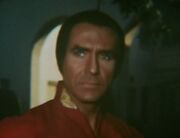
One of the few historic pictures of Khan from the 1990s
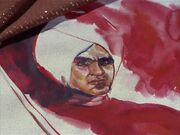
McGivers's portrait of a 20th century Khan.
Records of the period, including Khan's origins, are vague. He was the product of a selective-breeding and genetic engineering program, based on the eugenic philosophy that held improving the capabilities of a man improved the entire Human race. Augments produced by the program possessed physical strength and analytical capabilities considerably superior to ordinary Humans, and were created from a variety of Earth's ethnic groups. Khan's background was suspected to be Sikh, from the northern region of India.
Khan would live up to the axiom coined by one of his creators, "superior ability breeds superior ambition". By 1993, a wave of the genetic "supermen" including Khan, had simultaneously assumed control of more than 40 of Earth's nations. From 1992 to 1996, Khan was absolute ruler of more than one-quarter of Earth's population, including regions of Asia and the Middle East. Considered "the best of tyrants", he severely curtailed the freedoms of his subjects, but his reign was an exception to similar circumstances in Earth history – lacking internal massacres or wars of aggression.
In the mid 1990s, the Augment tyrants began warring amongst themselves. Other nations joined in to force them from power in a series of struggles that became known as the Eugenics Wars. Eventually, most of the tyrants were defeated and their territory re-captured, but up to 90 "supermen" were never accounted for.
Khan escaped the wars and their consequences along with 84 followers (including Joachim, Joaquin, Kati, Ling, McPherson, Otto and Rodriguez) who swore to live and die at his command. He saw his best option in a risky, self-imposed exile. In 1996, he took control of a DY-100-class interplanetary sleeper ship he christened SS Botany Bay, named for the site of the Australian penal colony. Set on a course outbound from the solar system, but with no apparent destination in mind, Khan and his people remained in suspended animation for Botany Bay's (nearly) 200-year sublight journey. (TOS: "Space Seed")
23rd century return
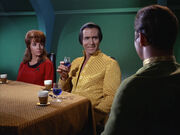
"Social occasions are only warfare concealed."
The USS Enterprise discovered the Botany Bay in the Mutara sector in 2267. The boarding party's arrival triggered Khan's stasis unit to revive him, but the ancient mechanism faltered. The decision of Captain James T. Kirk to remove him from the stasis chamber, and Dr. Leonard McCoy's subsequent ministrations, saved Khan's life.
Twelve of the stasis units failed during the voyage. Kirk, taking the Botany Bay in tow, left the remaining 72 sleepers for disposition at Starbase 12 following their leader's successful recovery. The Botany Bay's undocumented departure, and the fragmented records of the period, initially obscured the identity of the sleepers from the Enterprise crew; but the man with incredible recuperative powers in sickbay led Kirk to suspect their genetically-manipulated nature.
Khan took advantage of Kirk's hospitality, catching up with his lost history by absorbing the ship's technical manuals and finding a weakness in the attraction he engendered from the pliant and submissive ship's historian, Lieutenant Marla McGivers. At a dinner given in his honor, Khan regaled the Captain's table with a romantic interpretation of the Eugenics Wars, until he was finally prodded into declaring, "We offered the world order!"
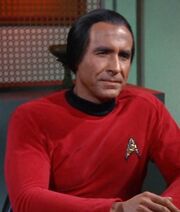
Khan wearing a Starfleet uniform
Eventually, Kirk and Spock identified their guest as being the deposed tyrant from Earth's past and Khan was confined to quarters. He soon began his takeover of the Enterprise, starting with his influence of McGivers. With her help, Khan escaped to the Botany Bay and revived his followers. Re-boarding the Enterprise, he took control from engineering and cut life support to the bridge. With the crew subdued and Kirk held hostage, Khan asked the officers to spare Kirk's life by joining in his quest to take the Enterprise to a colony "willing to be led" by himself (more correctly, to be conquered by him, a task which the arsenal of the Enterprise would make most simple). The officers' recalcitrance led McGivers, unwilling to go so far as to participate in murder, to betray Khan and release Kirk. Once the Augments were disabled with anesthetic gas, Khan attempted to destroy the Enterprise with a warp core overload as Kirk engaged the tyrant in physical combat. Khan's superior strength nearly won him the battle, but Kirk used a broken piece of equipment piping to defeat him.
Kirk retained some admiration for the determined, capable man of history. The prospect of imprisoning and rehabilitating the Augments seemed a waste. Instead, Kirk granted an opportunity for Khan and his followers: to colonize the dangerous but habitable world of Ceti Alpha V. McGivers was given the choice of facing court martial or joining the new colony. Khan accepted McGivers' company, and took up Kirk's challenge to "tame a world", citing Milton's Lucifer, "It is better to Rule in Hell, than Serve in Heaven". (TOS: "Space Seed")
Second exile
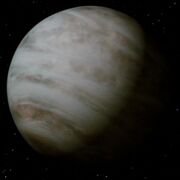
Ceti Alpha V in 2285
Along with Starfleet-issue cargo containers, Khan and his people settled in to life on their new world. Only six months after their landing, a cataclysm on Ceti Alpha VI shifted the system's orbits, causing massive ecological devastation on Ceti Alpha V. Khan's ingenuity and the meager shelter of the cargo containers kept his people alive while most of the indigenous life perished. The rugged Ceti eels survived, however, and as the only hosts available for their young, Khan's people were beset by the creatures. Over time, Khan lost twenty of his people to the slow, maddening death caused by the eels, including his "beloved wife."
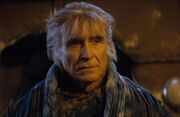
Khan, after being discovered by Terrell and Chekov
Neither Kirk nor Starfleet followed up on the colony's progress. The starship USS Reliant, attached to Project Genesis to find a suitable proving ground, finally arrived at the apparently lifeless world in 2285. Captain Clark Terrell and Commander Pavel Chekov, the latter of whom himself was a former Enterprise crewmember, beamed down to survey the planet they assumed to be Ceti Alpha VI, where they were captured by Khan. After inflicting inchoate, mind-altering "eels" on his captives, Khan demanded to know the nature of their mission and the whereabouts of James Kirk.
The beginning of vengeance
Using his captives' vulnerability to suggestion, Khan and his followers hijacked the Reliant, and marooned the crew on Ceti Alpha V. With knowledge of the awesome potential of the Genesis project, he used Chekov to notify spacelab Regula I of Reliant's pending arrival and their intention to retrieve all Genesis information, 'as ordered by Admiral Kirk.' Khan's lure proved successful. The Enterprise, engaged in a training cruise at the time, altered course to investigate the odd reports from Regula I.
Khan's lieutenant, Joachim, called out his superior on the beginnings of his obsessive behavior, insisting that he had already beaten Kirk by foiling his plans. Khan's reply gave the first indication of the price that exile on Ceti Alpha V exacted on his ability to reason or, more accurately, to govern his overpowering passions:
- "He tasks me! He tasks me, and I shall have him! I'll chase him 'round the moons of Nibia and 'round the Antares maelstrom and 'round Perdition's FLAMES before I give him up." – Khan, paraphrasing Ahab from Moby Dick, Or--The Whale.
Arriving at Regula I, Khan raged through the space station, seeking the now-missing Genesis data, and tortured those station crew members unable to escape the suspicious return of Reliant. When they proved uncooperative, he slaughtered them. He then left Terrell and Chekov behind, as they might prove a useful means to monitor Kirk's communications and follow his lead to Genesis, in the event that the Enterprise reached the station.

Khan intercepted the Enterprise, which was en route to Regula I. Concealing her intent, Reliant approached, feigning communications trouble, and mounting a devastating surprise attack using the Reliant's phasers to cripple the Enterprise. Khan hailed to gloat over his triumph and discuss terms of surrender. His only reward proved to be Kirk's initial open-mouthed stare of surprise. The parley allowed the more experienced starship commander to override the Reliant's tactical systems using the ship's prefix code to access them. With a few weak phaser shots from the Enterprise, the Reliant lost photon control and warp power (which would also disable the phasers), forcing Khan to retreat to Regula I.
After the Enterprise limped to the space station, a landing party led by Kirk rescued Terrell and Chekov from the storage locker Khan had imprisoned them in. After Kirk discovered the Genesis device in the bowels of the Regula planetoid, Terrell contacted Khan, who beamed the device to the Reliant. However, Terrell, fighting the effects of the Ceti Eel, refused Khan's order to kill Kirk and committed suicide. Despite the turn of events, Khan felt some small satisfaction, since Kirk and his party were now marooned within Regula, and the Reliant was on its way to find and destroy the Enterprise.
- "I've done far worse than kill you. I've hurt you. And I wish to go on hurting you. I shall leave you as you left me. As you left her. Marooned for all eternity at the center of a dead planet. Buried alive...buried alive." - Khan, to Kirk.
- "KHAAAAAAAAN!!!" - Kirk, in enraged response.
In an open communication with Kirk, Spock's simple coded message (beginning with the signal, "Hours would seem like days") led Khan to believe Enterprise would need two days to effect basic repairs, unaware that Spock was actually telling Kirk that those repairs would be complete in two hours. After discovering his prey under way at full impulse power and bound for the obscuring clouds of the Mutara Nebula, Khan's pursuit faltered on the advice of Joachim, who knew that pursuing the Enterprise into the nebula would disrupt shield and sensor functions for both vessels. A surprise hail from Kirk, alive and taunting from the Enterprise bridge, threw Khan into a rage, and his passions overcame him. Ignoring the consequences of engaging his enemy on the level playing field of the nebula, Khan spurred the Reliant after Kirk.
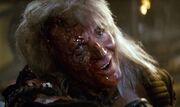
"For hate's sake, I spit my last breath at thee...."
The Battle of the Mutara Nebula was the last action of Khan's life. The two starships, barely able to discern one another due to interference within the nebula, exchanged a series of near misses and solid blows, until Kirk's experience finally trumped Khan's will; unused to fighting in a starship, Khan thought of the battle in terms of sailing ships, rather than submarines: he failed to realize until it was too late that he could have fought in three dimensions. After Kirk's new strategy allowed the Enterprise to catch Khan off-guard by descending and then rising to attack the Reliant from behind, Reliant was crippled and adrift with Khan's followers either dying or dead. Rather than surrender, Khan activated the Genesis device, hoping to take Kirk and the Enterprise along with him to oblivion. Unfortunately for him, Captain Spock managed to repair the damage to the Enterprise's engines which allowed the starship to escape at warp seconds before the Genesis Device detonated, destroying the Reliant and Khan with it. (Star Trek II: The Wrath of Khan)
- "From Hell's heart, I stab at thee... For hate's sake, I spit my last breath at thee..." - Khan's last words, from Captain Ahab in Herman Melville's Moby Dick.
Legacy
The geneticist Arik Soong believed Augments like Khan could be created without exhibiting his more vicious instincts. Soong's "children", created from augment embryos stolen in 2134, failed to live up to the hopes of their "father". Soong believed Khan and the Botany Bay to be nothing more than a myth, although his "children" believed differently. After his imprisonment in 2154, Soong, convinced by his creation's actions that his theory was dangerously wrong, redirected his efforts to the perfection of artificial humanity. His descendant, Noonian Soong (possibly, given Arik's admiration for him, named after Khan Noonien Singh) continued the effort with the invention of Soong-type androids, including B-4, Lore and ultimately, Data. (ENT: "Borderland", "The Augments"; TNG: "Datalore"; Star Trek Nemesis)
Khan's theft and premature detonation of the Genesis Device alarmed the Klingon Empire who mistakenly believed the device was the result of the Federation's development of an "ultimate weapon", increasing tensions between the two powers until the détente of 2293. Immediately, though, a group of renegade Klingons led by Kruge tried to steal the "Genesis torpedo" for themselves, but were unsuccessful. (Star Trek III: The Search for Spock; Star Trek IV: The Voyage Home; Star Trek VI: The Undiscovered Country)
In 2368, Captain Jean-Luc Picard of the USS Enterprise-D agreed with faux historian Berlinghoff Rasmussen that saving an endangered planet could allow "the next Adolf Hitler or Khan Singh" to come into being. According to the Captain, first year philosophy students had been asked the question ever since the first wormholes had been discovered. (TNG: "A Matter of Time")
Khan and his augment brethren were considered so dangerous that by the late-24th century, genetic engineering was banned throughout the United Federation of Planets (except as treatment for serious medical conditions) in order to avoid creating another tyrant like Khan, although Doctor Sara Kingsley and her colleagues continued genetic engineering research in the 24th century. A black market in the genetic manipulation of children with limited abilities continued, however, resulting in the enhancement of Humans like Dr. Julian Bashir. (TNG: "Unnatural Selection"; DS9: "Doctor Bashir, I Presume")
Upon facing Khan in 2259 of the alternate reality, the prime universe's Khan was the subject of a discussion, via viewscreen, between Spock from the alternate reality, who was aboard the USS Enterprise, and his counterpart from the prime one, who was on New Vulcan. The version of Spock from the prime universe - so alarmed upon hearing the name that he chose to break his vow never to tell his younger self anything about the future - recalled that, in that timeline, Khan had been "the most dangerous adversary the Enterprise ever faced", and that defeating him had come at a great cost. In this timeline, Khan was defeated by Spock and Uhura, but Kirk died saving the ship in Spock's place. However, that universe's McCoy discovered that Khan's blood had regenerative properties and was able to use it to resurrect Kirk. (Star Trek Into Darkness)
Appendices
Appearances
References
- TNG: "A Matter of Time"
- DS9: "Doctor Bashir, I Presume"
- Star Trek films:
Background information
In Carey Wilber's original draft of "Space Seed", Khan is a blonde criminal named Harold Erickson, who was placed in stasis aboard the Botany Bay as a means of getting rid of prisoners during an overpopulated era of Earth's history. Gene L. Coon's rewrites transformed the character into Ragnar Thorwald, the genetically enhanced leader of the "First World Tyranny", who hides behind the pseudonym John Erickson.
Khan was played by Ricardo Montalban in both of the character's appearances. His casting prompted the writers to change the character's name to Sabahl Khan Noonien, after Kim Noonien Wang, a friend of Gene Roddenberry during the Second World War. Roddenberry had lost touch with him and hoped that his friend would see his name on television and contact him. (This was also the origin of the name of Noonian Soong.) NBC suggested changing the character's name to Govin Bahadur Singh, due to the racial implications of the name "Khan", but Roddenbery insisted on keeping Khan and Noonien. [1]
After the release of The Wrath of Khan, Roddenberry (who disliked almost all of the film's many aspects) commented, "Khan was not written as that exciting a character, he was rather flimsy. The Khan in the TV episode was a much deeper and better character than the movie Khan, except that Montalban pulled it off." (Captains' Logs: The Unauthorized Complete Trek Voyages)
Khan's periodic quotations in Star Trek II: The Wrath of Khan were paraphrases, or direct lifts, from Herman Melville's Moby Dick.
To account for a discrepancy wherein Khan recognizes Chekov in The Wrath of Khan though Chekov's first appearance on TOS was not until the show's second season, a long-standing joke involving Khan has come about, as told by Chekov actor Walter Koenig. It postulates that, because Chekov left Khan waiting too long to use the bathroom, Khan vowed never to forget his face.
Besides Captain John Christopher in "Tomorrow is Yesterday", and Charles Evans in "Charlie X", Khan, in "Space Seed", is the only other Enterprise guest to be given, during the course of TOS, a Starfleet uniform to wear (although Craig Hundley wore a child's version of a Starfleet uniform in a scene that was cut from "Operation -- Annihilate!"). In accordance with Khan's assertion that he was once "an engineer, of sorts," his uniform shirt is red.
The Starfleet insignia around Khan's neck in Wrath of Khan is a broken, movie-era Starfleet uniform buckle, although the necklace appears on Khan before he actually gets aboard the Reliant. It is known as the "Buckle Necklace", according to Star Trek: The Experience at the Las Vegas Hilton.
The surname "Singh" suggests northern Indian ancestry (from the Sanskrit simha, "lion") and possibly roots in Sikhism (male Sikhs are obliged to assume the surname "Singh", regardless of their geographical or familial origins); while "Khan" ("ruler") is a name of central Asian origin generally associated with Islam.
Along with Harry Mudd, Khan is one of only two opponents to face Kirk more than once in live-action Star Trek productions.
The portrayal of Khan in The Wrath of Khan immediately appealed to Alex Kurtzman. He later remarked about Khan, "Not only is he scary, but he has an extremely personal and specific agenda that was understandable despite being psychotic. I think anyone who loves Trek would immediately vault Khan to the top of the villain list." [2]
When asked about the prime Khan being mentioned in Star Trek Into Darkness, Damon Lindelof said, "It would have been hubris for us to represent to the uninitiated that Khan was our idea and there was no one better [than Spock] to pop in briefly and say — 'Hey, these guys are just doing their own spin on a bad guy that was around a long time before they came along.' The minute we stop honoring, acknowledging and representing the original Trek, we are bound to lose sight of the enormous gift we have been given in sustaining it." [3]
While filming that scene, Leonard Nimoy responded to Spock's line, inquiring how the prime reality Enterprise crew originally defeated Khan, by quipping, "We picked up a hammer...", referencing how Kirk originally beat Khan into submission. ("Mr. Spock and Mr. Spock" featurette, Star Trek Into Darkness Blu-ray)
Apocrypha
A trilogy by author Greg Cox describes the other events of Khan's life. The Eugenics Wars: The Rise and Fall of Khan Noonien Singh, Volume One chronicles the genetic enhancement project that led to his birth, and shows some of his early childhood from the point of view of agents Gary Seven and Roberta Lincoln in the 1970s. The sequel, The Eugenics Wars: The Rise and Fall of Khan Noonien Singh, Volume Two shows his rise to power and capturing Seven's technology, as well as how he was able to secretly control so much of the world without the average citizen ever knowing. The final part of the trilogy is To Reign in Hell: The Exile of Khan Noonien Singh, which explains his life on Ceti Alpha V after being left there to fend for himself, his followers, and his wife, to the point where Chekov and Captain Terrell encounter him years later.
James Swallow wrote an alternate history novella entitled "Seeds of Dissent" for the Myriad Universes: Infinity's Prism anthology. In it, Khan won the Eugenics Wars and went on to establish an interstellar empire, eventually dying at the age of 213. The Botany Bay is then said to have been launched in 2010 by Wilson Evergreen and carrying Shaun Geoffrey Christopher, Shannon O'Donnell and Rain Robinson to escape Khan's despotism. In the Star Trek: The Next Generation novel Dark Mirror, it is also mentioned that the mirror universe Khan won the Eugenics Wars instead of being forced to leave the planet. In the Star Trek: Mirror Universe novel The Sorrows of Empire, the mirror universe counterpart of Colonel West mentions Ranjit Singh as a descendant of Khan and a potential prospect to replace Spock as Emperor of the Terran Empire, implying that Khan or someone of his bloodline ruled the Empire in the past.
Khan is the protagonist of the comic book Star Trek: Khan - Ruling in Hell, covering the same timeframe as To Reign in Hell.
In Star Trek Online, one of the Federation players' earliest foes is a descendant of Khan, Dr. Amar Singh, a scientist who leads a group known as the "Children of Khan" and conducts experiments in Augment enhancement for the Klingon Empire, combining Klingon, Gorn and Augment genetics to create the ultimate superbeing. He is defeated and captured by Federation players, later appearing at the prison colony known as Facility 4028, where the Female Changeling is held.
Trivia
Khan Noonien Singh inspired the creation of Mogul Khan, a brutish warrior in the video game, Defense of the Ancients II. According to dota2.gamepedia.com/Axe, Khan was described as a brutal "one-man army" in the game, a "superior bred specimen" which could be a hint to Khan.
External links
- [4]
- Template:NCwiki
- Khan Noonien Singh at Wikipedia
Featured revision (439106) • Diff to current • Blurb
